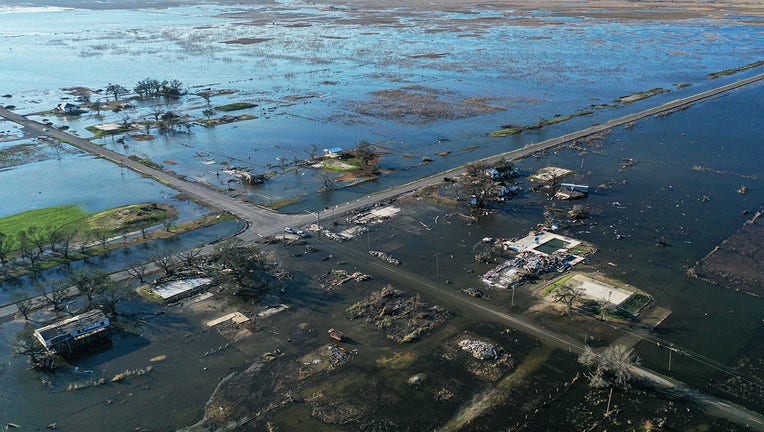Wells Fargo study shows most Americans not ready for natural disasters: How you can prepare

A new study from Wells Fargo shows many Americans are not prepared for a natural disaster. (iStock)
Natural disasters continue to be a problem in the U.S., and a new study from Wells Fargo shows many Americans are not physically or financially prepared when they do hit.
About 84% of Americans currently live in areas that have experienced some form of a natural disaster in the past three years, the study released Sept. 22 found. And 54% of those respondents live in areas that have experienced severe natural disasters such as hurricanes, tornadoes, floods, wildfires or earthquakes. Additionally, 72% of Americans said their families were personally affected by a natural disaster at some point in their lifetime.
However, despite this close proximity to natural disasters, 71% of Americans said they do not have a detailed plan in case they’re impacted by one, the survey showed.
One way to ensure you’re prepared is to choose the correct home insurance plan. With the right homeowner’s insurance, you can be more financially prepared if a disaster does occur. Visit Credible to compare plans from multiple companies and see which one works best for you.
FEMA'S NEW FLOOD INSURANCE METHODOLOGY COULD CAUSE RATE DROP FOR 1.2M POLICYHOLDERS, DATA SHOWS
Many Americans are unprepared for natural disaster events
Among Americans who said they are not prepared for a natural disaster, 40% said they’ve never thought about making a plan, 35% are more focused on immediate issues, 31% haven’t gotten around to it and 16% said they don’t know how to prepare, the survey found.
"The survey affirms a lack of physical preparedness as well as financial readiness for emergencies for most people," Rullah Price, Wells Fargo head of public affairs resiliency and enterprise incident communications, said. "Given that half of those surveyed said they would like their bank to proactively help them plan for a natural disaster, I believe there’s an opportunity for Wells Fargo to educate and inspire people to make some changes for the better – starting now."
If you're looking for ways to prepare, you could consider taking out homeowner’s insurance that covers damage from more common natural disasters in your area. Having the right coverage can save you money in an emergency, and comparing multiple providers can also help you save on your monthly payments. Visit Credible to enter your information once and see offers from multiple providers.
BIDEN ADMINISTRATION EXTENDS ADDITIONAL MORTGAGE RELIEF OPTIONS FOR FHA LOANS
Plans and finances are incomplete
The Wells Fargo survey found that even when consumers do have a plan, it is often incomplete. Among those with a plan, 78% prioritized having food and water supplies, 63% included emergency cash, 61% wanted access to important documents and 59% listed a planned transportation and evacuation route. The plans also included lower prioritized items such as medical needs (54%), a family communication plan (52%), a shelter plan (49%) or a plan for pets (44%).
"Most people’s plans are lacking in detail," Price said. "It’s necessary to really think through all the possible scenarios. For example, only a quarter of respondents have outlined specific plans for members in the household of different ages. This is incredibly important for vulnerable ones like children and seniors."
Important items to include in a preparedness evacuation plan kit, in case of a storm or other emergency, include:
- Batteries
- Medications, prescriptions and other medical care
- First aid kit
- Flashlights
- Blankets
- Nonperishable food
To ensure you’re ready for any scenario, create an emergency plan and prepare your home. And make sure you have the right protections, such as potential flood insurance. You can visit Credible to get prequalified for homeowner’s insurance in minutes without affecting your credit score.
In addition to not being physically prepared, the study also found that only 44% of Americans have an emergency savings account, and many do not keep cash. Another 39% said they don’t keep emergency cash in the house, and 11% have $100 or less cash at home.
"We are evolving to a cashless society—but during an emergency, cash is what’s needed," Price said. "In times of natural disaster, you may not have easy access to an ATM, and credit cards may not work if electricity is out. It’s important to be prepared for all possible events."
If you’re dealing with the impacts of a national disaster and don’t have emergency savings, you could consider taking out a personal loan while interest rates are near record lows. This can help you cover immediate needs. Visit Credible to compare personal loan options from multiple lenders at once.
How to prepare for a natural disaster
To ensure Americans are prepared for a natural disaster, there are a few steps they can take. Among them is to create an emergency kit that includes important documents such as passports, social security cards and birth certificates. It should also contain food and water supplies, extra cash and other necessities.
Americans should also have their finances in order and keep an emergency savings account. If they do not have enough in their account to cover their needs or emergency repairs, personal loans are available to help to cover expenses. Visit Credible to find your personalized rate.
Homeowners should also ensure they have sufficient coverage for natural disasters that could hit their area. Visit Credible to speak to a homeowner’s insurance expert and get your questions answered.
Have a finance-related question, but don't know who to ask? Email The Credible Money Expert at moneyexpert@credible.com and your question might be answered by Credible in our Money Expert column.

